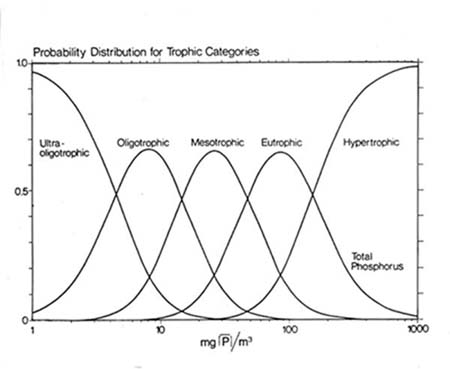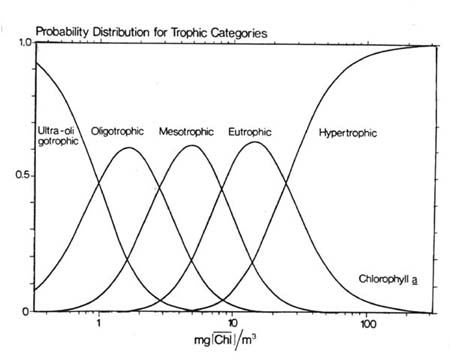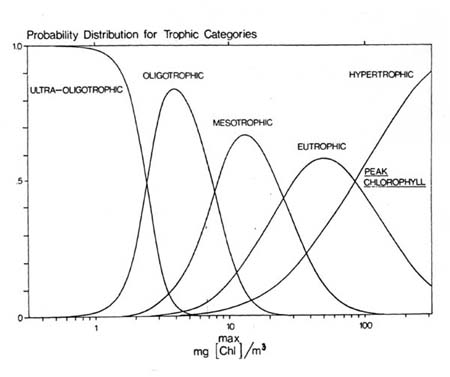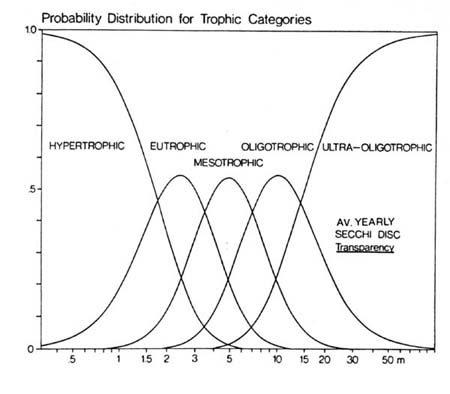Disclaimer & Copyright Notices; Optimized for the MS Internet Explorer
An absolute minimum sampling frequency of four times per year was recommended (winter, summer, spring, and autumn overturn) and a sampling frequency of at least once a month during periods of stratification. During the period of stratification, samples are essential from above and below the thermocline and from lower down in the hypolimnion. Samples from the hypolimnion very close to the lake bottom were particularly important. It was stressed that several sampling stations were required to describe conditions in lakes with complex morphometry, but if this was not possible, the minimum provision was that the lake should be sampled at the deepest point (or points). Only this minimum provision was followed in many cases and often a distorted picture of the average lake concentration resulted. Infrequent sampling usually gives a distorted picture of the resultant variables which have short-term variability and it is inadequate for the determination of peak values of chlorophyll a and daily primary production.
Depending on the conditions that exist in a water body, infrequent sampling might give adequate information for calculation of a mean value; this is true for most pristine oligotrophic lakes. It could, however, give a rather distorted picture in a highly eutrophic lake with a seasonally variable nutrient load.
The advantage of a fixed boundary system is its easy application by managers and technical personnel with only limited limnological training. In particular, it is apt to prevent gross misuse of the trophic terminology, which has often happened in the past.
| Trophic Category (Annual Mean Values) | [P]λ | [chl] | [max. chl] | [Sec]y | [min. Sec]y |
|---|---|---|---|---|---|
| mg/m3 | m | ||||
| Ultra-oligotrophic ..... | ≤ 4.0 | ≤ 1.0 | ≤ 2.5 | ≥ 12.0 | ≥ 6.0 |
| Oligotrophic ........... | ≤ 10.0 | ≤ 2.5 | ≤ 8.0 | ≥ 6.0 | ≥ 3.0 |
| Mesotrophic ....... | 10 - 35 | 2.5 - 8 | 8 - 25 | 6 - 3 | 3 - 1.5 |
| Eutrophic ....... | 35 - 100 | 8 - 25 | 25 - 75 | 3 - 1.5 | 1.5 - 0.7 |
| Hypertrophic ....... | ≥ 100 | ≥ 25 | ≥ 75 | ≤ 1.5 | ≤ 0.7 |
The uncertainty in allocating a lake to a given category is taken into account and therefore, the probabilistic aspect becomes an important judgement element in predictive application of the system.In essence, it represents the qualified majority opinion of a large group of limnologists of how the trophic terminology is, and ought to be, applied in practice.
Accordingly, two lakes with numerically similar characteristics (which is always only one part of a qualitatively oriented judgement) may appear in different (though neighbouring) categories. However, as a rule it may be assumed that a gross error in allocation is made if more than one of the parameters used to define the trophic nature of a lake deviates by more than ± 2 standard deviations from the corresponding group means.
| Variable (Annual Mean Values) | Oligotrophic | Mesotrophic | Eutrophic | Hypertrophic | |
|---|---|---|---|---|---|
| Total Phosphorus mg/m3 | x x ± 1 SD x ± 2 SD Range n | 8.0 4.85 - 13.3 2.9 - 22.1 3.0 - 17.7 21 | 26.7 14.5 - 49 7.9 - 90.8 10.9 - 95.6 19 | 84.4 48 - 189 16.8 - 424 16.2 - 386 71 | 750 - 1200 2 |
| Total Nitrogen mg/m3 | x x ± 1 SD x ± 2 SD Range n | 661 371 - 1180 208 - 2103 307 - 1630 11 | 753 485 - 1170 313 - 1816 361 - 1387 8 | 1875 861 - 4081 395 - 8913 393 - 6100 37 | |
| Chlorophyll a mg/m3 | x x ± 1 SD x ± 2 SD Range n | 1.7 0.8 - 3.4 0.4 - 7.1 0.3 - 4.5 22 | 4.7 3.0 - 7.4 1.9 - 11.6 3.0 - 11 16 | 14.3 6.7 - 31 3.1 - 66 2.7 - 78 70 | 100 - 150 2 |
| Chlorophyll a Peak Value mg/m3 | x x ± 1 SD x ± 2 SD Range n | 4.2 2.6 - 7.6 1.5 - 13 1.3 - 10.6 16 | 16.1 8.9 - 29 4.9 - 52.5 4.9 - 49.5 12 | 42.6 16.9 - 107 6.7 - 270 9.5 - 275 46 | |
| Secchi Depth (m) | x x ± 1 SD x ± 2 SD Range n | 9.9 5.9 - 16.5 3.6 - 27.5 5.4 - 28.3 13 | 4.2 2.4 - 7.4 1.4 - 13 1.5 - 8.1 20 | 2.45 1.5 - 4.0 0.9 - 6.7 0.8 - 7.0 70 | 0.4 - 0.5 |




![[Img-probability-example-1]](PIC/probability-example-1.jpg)
We salute the Chebucto Community Net (CCN) of Halifax, Nova Scotia, Canada for hosting our web site, and we applaud its volunteers for their devotion in making `CCN' the best community net in the world